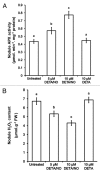Nitric oxide increases the enzymatic activity of three ascorbate peroxidase isoforms in soybean root nodules
- PMID: 21494099
- PMCID: PMC3257769
- DOI: 10.4161/psb.6.7.14879
Nitric oxide increases the enzymatic activity of three ascorbate peroxidase isoforms in soybean root nodules
Abstract
Ascorbate peroxidase is one of the major enzymes regulating the levels of H2O2 in plants and plays a crucial role in maintaining root nodule redox status. We used fully developed and mature nitrogen fixing root nodules from soybean plants to analyze the effect of exogenously applied nitric oxide, generated from the nitric oxide donor 2,2'-(hydroxynitrosohydrazono)bis-ethanimine, on the enzymatic activity of soybean root nodule ascorbate peroxidase. Nitric oxide caused an increase in the total enzymatic activity of ascorbate peroxidase. The nitric oxide-induced changes in ascorbate peroxidase enzymatic activity were coupled to altered nodule H2O2 content. Further analysis of ascorbate peroxidase enzymatic activity identified three ascorbate peroxidase isoforms for which augmented enzymatic activity occurred in response to nitric oxide. Our results demonstrate that nitric oxide regulates soybean root nodule ascorbate peroxidase activity. We propose a role of nitric oxide in regulating ascorbate-dependent redox status in soybean root nodule tissue.
Figures




References
-
- Besson-Bard A, Pugin A, Wendehenne D. New insights into nitric oxide signaling in plants. Annu Rev Plant Biol. 2008;59:21–39. - PubMed
-
- Hong JK, Yun BW, Kang JG, Raja MU, Kwon E, Sorhagen K, et al. Nitric oxide function and signalling in disease resistance. J Exp Bot. 2008;59:154–174. - PubMed
-
- Manjunatha G, Lokesh V, Neelwarne B. Nitric oxide in fruit ripening: Trends and opportunities. Biotechnol Adv. 2010;28:489–499. - PubMed
-
- Qiao W, Fan LM. Nitric oxide signaling in plant responses to abiotic stresses. J Integr Plant Biol. 2008;50:1238–1246. - PubMed
-
- Wilson ID, Neill SJ, Hancock JT. Nitric oxide synthesis and signalling in plants. Plant Cell Environ. 2008;31:622–631. - PubMed
Publication types
MeSH terms
Substances
LinkOut - more resources
Full Text Sources
Miscellaneous
